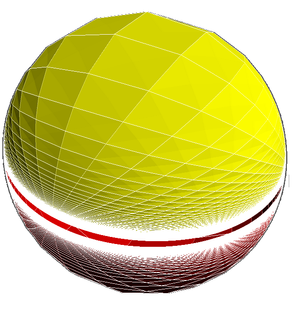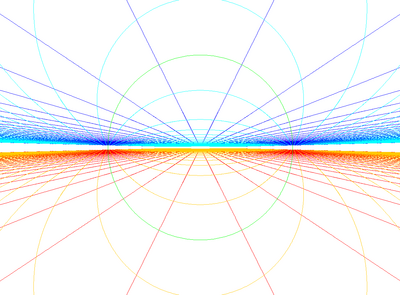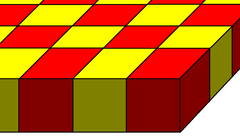Order-4 square hosohedral honeycomb
| Order-4 square hosohedral honeycomb | |
|---|---|
 Centrally projected onto a sphere | |
| Type | Degenerate regular honeycomb |
| Schläfli symbol | {2,4,4} |
Coxeter diagrams |
|
| Cells | {2,4} |
| Faces | {2} |
| Edge figure | {4} |
| Vertex figure | {4,4}
|
| Dual | Order-2 square tiling honeycomb |
Coxeter group |
[2,4,4] |
| Properties | Regular |
In
square hosohedra {2,4} around each edge. In other words, it is a packing of infinitely tall square columns. It is a degenerate honeycomb in Euclidean space, but can be seen as a projection onto the sphere. Its vertex figure, a square tiling
is seen on each hemisphere.
Images
Stereographic projections of spherical projection, with all edges being projected into circles.
 Centered on pole |
 Centered on equator |
Related honeycombs
It is a part of a sequence of honeycombs with a square tiling vertex figure:
| {p,4,4} honeycombs | ||||||
|---|---|---|---|---|---|---|
| Space | E3 | H3 | ||||
| Form | Affine | Paracompact | Noncompact | |||
| Name | {2,4,4} | {3,4,4} | {4,4,4} | {5,4,4} | {6,4,4}
|
.. {∞,4,4}
|
| Coxeter |
||||||
| Image | 
|

|

|

|

|

|
| Cells |  {2,4} |
 {3,4} |
 {4,4} |
 {5,4} |
 {6,4} |
 {∞,4} |
Truncated order-4 square hosohedral honeycomb
| Order-2 square tiling honeycomb Truncated order-4 square hosohedral honeycomb  Partial tessellation with alternately colored cubes | |
|---|---|
| Type | uniform convex honeycomb
|
| Schläfli symbol | {4,4}×{} |
Coxeter diagrams |
|
| Cells | {3,4} |
| Faces | {4} |
| Vertex figure | Square pyramid |
| Dual | |
Coxeter group |
[2,4,4] |
| Properties | Uniform |
The {2,4,4} honeycomb can be truncated as t{2,4,4} or {}×{4,4}, Coxeter diagram ![]()
![]()
![]()
![]()
![]()
![]()
![]() , seen as a layer of cubes, partially shown here with alternately colored cubic cells. Thorold Gosset identified this semiregular infinite honeycomb as a cubic semicheck.
, seen as a layer of cubes, partially shown here with alternately colored cubic cells. Thorold Gosset identified this semiregular infinite honeycomb as a cubic semicheck.
The alternation of this honeycomb, ![]()
![]()
![]()
![]()
![]()
![]()
![]() , consists of infinite square pyramids and infinite tetrahedrons, between 2 square tilings.
, consists of infinite square pyramids and infinite tetrahedrons, between 2 square tilings.
See also
References
- The Beauty of Geometry: Twelve Essays (1999), Dover Publications, ISBN 0-486-40919-8 (Chapter 10, Regular Honeycombs in Hyperbolic Space)
